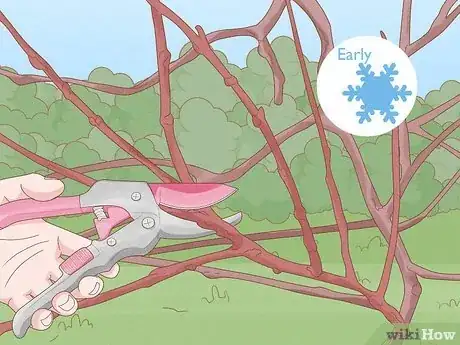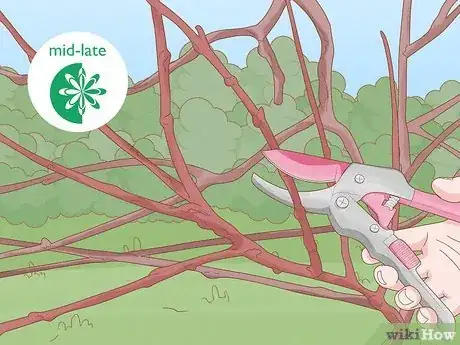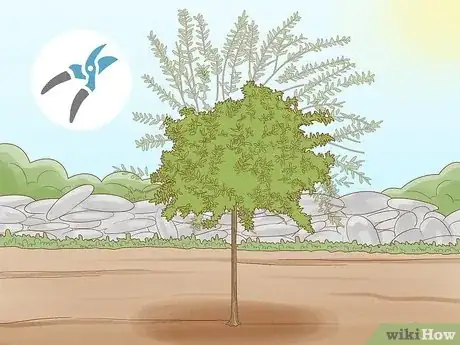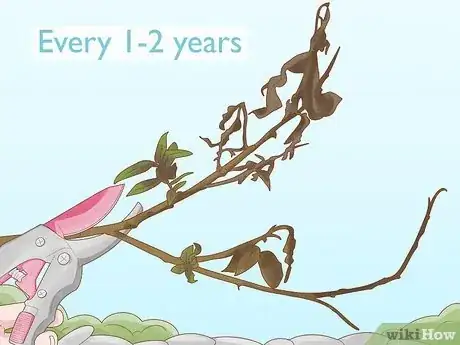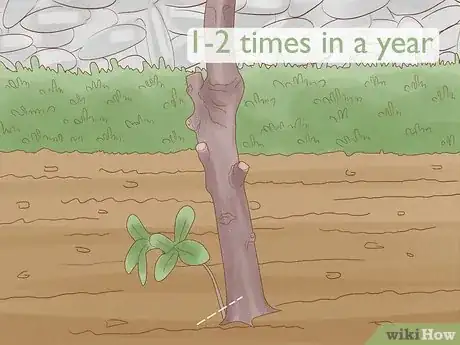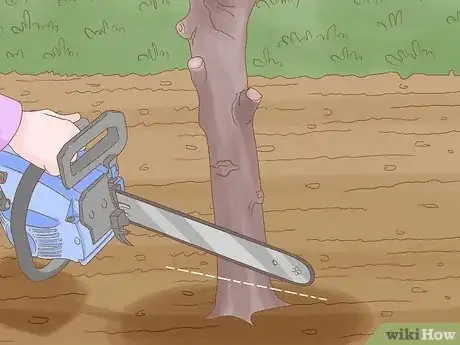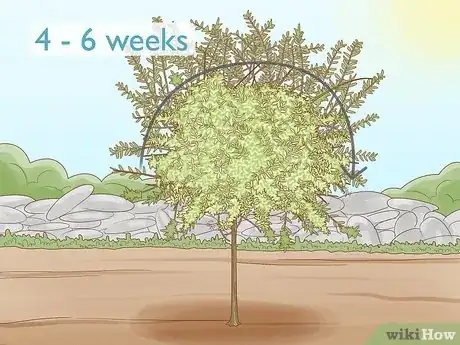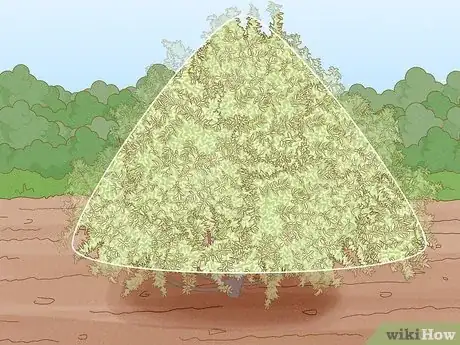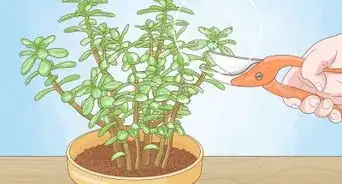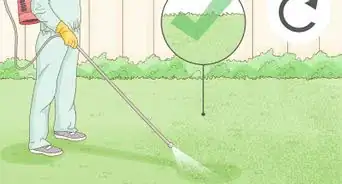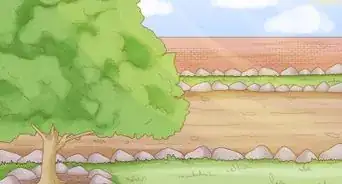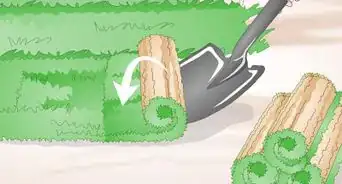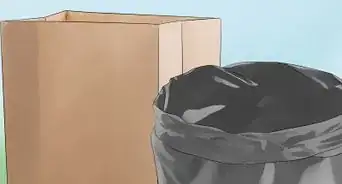This article was co-authored by Lauren Kurtz. Lauren Kurtz is a Naturalist and Horticultural Specialist. Lauren has worked for Aurora, Colorado managing the Water-Wise Garden at Aurora Municipal Center for the Water Conservation Department. She earned a BA in Environmental and Sustainability Studies from Western Michigan University in 2014.
There are 7 references cited in this article, which can be found at the bottom of the page.
wikiHow marks an article as reader-approved once it receives enough positive feedback. In this case, 100% of readers who voted found the article helpful, earning it our reader-approved status.
This article has been viewed 99,054 times.
Pruning a dappled willow is much like pruning any dense hedge type plant. You should do extensive pruning in winter or early spring, such as thinning out the plant. However, you can also shape the plant near the end of summer, as well as prune it to open up the canopy to increase light penetration. Pick pruning or shaping the hedge more effectively can help it get the light it needs. If you want to heal a weakened or diseased plant, you may want to cut it back completely to the ground.
Steps
Timing Pruning Correctly
-
1Prune for rejuvenation in early winter. You can prune a dappled willow as early as the beginning of winter, when the plant has gone dormant. You can prune it once the weather has turned cold for good in your area.[1]
- You may be able to prune it as early as late November.
-
2Prune before mid- to late spring. You can wait to thin or cut back branches to the end of winter, but don't go past early spring. You want to do this type of pruning before new growth begins.[2]Advertisement
-
3Trim the shape in late summer. If you are just trimming the top of the plant and not removing more than 10 percent of the tree, you can trim in late summer. It's a good time because new growth is over and you can get a good idea of how much growth the plant has had when the leaves are still on it.
Using Pruning to Rejuvenate or Maintain Growth
-
1Thin the dappled willow for a natural form. You can simply thin out branches if you want to keep the willow in a natural form. Cut select branches down to the ground every 1-2 years, and you will have a tall tree that produces an array of blooms.[3]
- Use pruning shears or loppers for this purpose.
- Pick the tallest and oldest branches first. The oldest growth will be the widest, heaviest branches. Cut those off near the ground. Try not to even leave a stub above the ground.[4]
- You can take 1 to 5 branches or about a third of the branches.
-
2Cut off weak or diseased branches. Cut back any branches that are dead, diseased, or weak-looking with bypass shears. You should also cut split or crossed branches off. Work from the top to the bottom.[5]
- If the branches are larger than 0.5 inches (1.3 cm), use lopping shears.
-
3Trim offshoots. This plant tends to sucker more than most, meaning it produces offshoots near the base of the plant. Trim these offshoots at the ground 1 to 2 times a year as they appear.
-
4Chop the plant to the ground if it has become unruly or unhealthy. Sometimes, your plant has been neglected for too long or its branches have been weakened in some way, such as by a storm. In that case, it may be better to cut it back completely. Trim all branches back until they're a couple of inches off the ground, and let it grow back.[6]
- After you use this technique, make sure you pay special attention to watering and fertilizing the plant.
Creating a Shape
-
1Shear off the tops of branches to reduce the height. If you want to form a shape, you can cut off the tops of branches to make a shape. Cut at lateral buds and side branches. You can trim every 4 to 6 weeks if you prefer.[7]
- Lateral buds are ones that grow to the side instead of up. Cut just above a healthy bud, leaving about 0.25 inches (0.64 cm) of branch above it.
- It's important to cut some side branches off, as after thinning the bush, some branches may become leggy. Simply pick branches that are at a 45-degree angle to main trunks and are about half the size. Trim them back close to the trunk.[8]
-
2Trim off branches near the bottom if you want bare trunks. The trunks will branch out all the way to the ground. If you prefer a bare look near the bottom, you can trim the branches off up to your chosen height to create the look you want. Cut the branches off near the trunk with hand shears.[9]
-
3Use pick pruning if you have a dense hedge. You can form a dense hedge with this plant, but you do need to let light into the bottom of the hedge. With this method, you cut a few little inconspicuous holes in the top of the plant to let light through to the bottom.[10]
- As you're trimming for height, cut some branches down into the plant rather than right at the height you want. That way, you're creating space in the top.
-
4Keep hedges wider at the bottom. If you are creating a hedge shape, shape it so it's a bit wider at the bottom. That way, light will be able to reach the whole plant more effectively.[11]
- As you prune the plant for shaping or pick pruning, curve the plant back in towards the top, creating an "A" shape. That creates space at the bottom for the plant to get more light.[12]
Community Q&A
-
QuestionSill I kill my dappled willow if I cut it back severely?
 Community AnswerIt depends on the time of year, and how severely you prune it. Later in the year is better for it. If you bare the roots, your willow will die of malnutrition.
Community AnswerIt depends on the time of year, and how severely you prune it. Later in the year is better for it. If you bare the roots, your willow will die of malnutrition. -
QuestionI bought a dappled willow shrub and on the growing instructions it says, "Trim often to maintain variegation in new growth." Do you know what "often" means in this context? I want the shrub to grow!
 Community AnswerIf the leaves are starting to lose variegation, prune it back a bit. It depends on how large your plant is. If it's only a few inches tall, do not prune. Let it grow until it's knee high. Then you can trim 1 or 2 inches off the branch tips. If it has grown too large, it's okay to cut it back. This is best done in early Spring before growth starts. Also, do not prune the plant after August or September. It will drop its leaves and go dormant in winter. Remember: The plant will tell you when to prune it back (when it loses much of the variegation).
Community AnswerIf the leaves are starting to lose variegation, prune it back a bit. It depends on how large your plant is. If it's only a few inches tall, do not prune. Let it grow until it's knee high. Then you can trim 1 or 2 inches off the branch tips. If it has grown too large, it's okay to cut it back. This is best done in early Spring before growth starts. Also, do not prune the plant after August or September. It will drop its leaves and go dormant in winter. Remember: The plant will tell you when to prune it back (when it loses much of the variegation). -
QuestionI live in Minnesota and have a dappled willow that has dead branches. Can I trim it back in July?
 Community AnswerNo good will come from leaving a dead branch on the plant. Cut it back to the last living bud.
Community AnswerNo good will come from leaving a dead branch on the plant. Cut it back to the last living bud.
References
- ↑ https://www.midwestgardentips.com/plant-spotlights/hakuro-nishiki-dappled-willow
- ↑ https://www.midwestgardentips.com/plant-spotlights/hakuro-nishiki-dappled-willow
- ↑ https://www.midwestgardentips.com/plant-spotlights/hakuro-nishiki-dappled-willow
- ↑ http://www.hawkslandscape.com/willow-pruning-winter-care-and-fertilizing-2/
- ↑ https://extension2.missouri.edu/MG8
- ↑ http://msue.anr.msu.edu/news/spring_shape_up_tidying_up_your_plants
- ↑ https://www.midwestgardentips.com/plant-spotlights/hakuro-nishiki-dappled-willow
- ↑ https://extension2.missouri.edu/MG8
- ↑ https://www.midwestgardentips.com/plant-spotlights/hakuro-nishiki-dappled-willow
About This Article
To prune a dappled willow, wait until early winter when the weather has turned cold for good in your area and the plant has gone dormant. If you want to keep the willow in a natural form, simply cut off select branches down to the ground with pruning shears to thin the willow out every 1 or 2 years. Focus on cutting off the oldest, thickest branches, as well as any diseased branches or offshoots near the base. If you want to form a shape, trim the tops of the branches with hand shears every 4 to 6 weeks. Keep your hedges wider at the bottom so light will be able to reach the whole plant more effectively. For more tips from our Horticulture co-author, like how to care for a dense hedge by pick pruning, keep reading!
